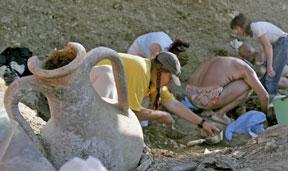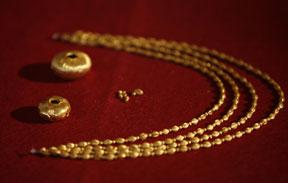A series of extraordinary discoveries made in Serbia and Bulgaria last month highlights the region's unique archaeological potential.
Lily Lynch
Source -http://www.setimes.com/cocoon/setimes/xhtml/en_GB/features/setimes/articles/2012/07/02/reportage-01

Bulgarian archaeologists uncovered a Thracian tomb five summers ago, but new digs may be even more significant. [Reuters]
Nemanja Mrdjic and his team of fellow archaeologists were excavating a Roman cemetery when they stumbled upon something quite unexpected: a mammoth graveyard containing the skeletons of at least five of the extinct creatures, the first of its kind in the world.
The rare finding in the city of Kostolac, east of Belgrade, has drawn media attention from around the globe. Yet the unearthing of the world's first mammoth field is just one in a series of extraordinary archaeological discoveries made in Serbia and the region in June.
"Archaeology in Serbia, but also in the Balkans in general is a goldmine of world archaeology right now," Miljana Radivojevic, researcher at the Centre for Research in Archaeological Materials at the University College London told SETimes.
This newfound status highlights new opportunities for the development of tourism and regional collaboration.
Also announced in mid-June was the unearthing of a 4,000-year-old necropolis near Vranje in southern Serbia. It is the only fully reserved necropolis from the Early Bronze Age period in the region. The necropolis was discovered on the so-called Corridor 10 highway, which stretches from Grabovnica near Leskovac in southern Serbia to Presevo near the border with Macedonia. The corridor contains about 33 registered archaeological sites, five of which have yet to be explored.
The third major archaeological finding in recent weeks was made in neighbouring Bulgaria, where "vampire" skeletons from the Middle Ages were discovered with iron rods in their chests. Vampire folk legends have existed in the region for many hundreds of years.
These findings, headline-making around the world, reveal the variety of contributions archaeological discoveries can offer the region.

Bronze Age gold jewelry was displayed in October 2008 after being discovered at a dig site in southeast Bulgaria. The newest excavations uncovered so-called ‘vampire skeletons’. [Reuters]
"The discovery of a fully preserved Early Bronze Age necropolis showcases again the rich archaeological heritage Serbia has within its territory. The sensational find of a mammoth herd in Kostolac is yet another example of the unique archaeological potential this country has. This potential, however, has yet to receive sufficient support from the state, not only for primary research, such as archaeological excavations, but also for developing the touristic potential that could equally benefit state and local communities," Radivojevic said.
Indeed, the discovery of "vampire" skeletons in Bulgaria has already given the country's tourism industry a major boost. According to eTN, an online news portal that covers global tourism, travel agencies have reported a surge of interest in so-called "vampire vacations" since the discovery made international headlines last month.
The interest will likely fuel the already booming tourism industry in Bulgaria. According to Eurostat, the country recorded a 20% increase in the number of hotel stays of foreigners last year, the most dramatic increase of any EU country. Investments have already been made in the region in which the remains were found, to help market them as a tourist attraction.
While Bulgaria has rushed to capitalise on its archaeological finds, Serbia has yet to fully tap the potential of its own findings. Sandra Vlatkovic, spokesperson for the National Tourism Board of Serbia, told SETimes, "The National Tourism Board promotes everything we have, and does promote history and culture in Serbia, though none of our offerings are exclusively focused on archaeology."
Vlatkovic acknowledged the potential for discoveries like the mammoth field in Kostolac and the Bronze Age necropolis near Vranje to draw tourists to Serbia. "There are many beautiful and exciting things to see in our country, but the negative news which you hear about so much in the international press can ruin everything, and prevent visitors from wanting to come here," she said.
While enriching the potential for the development of tourism, major archaeological discoveries also offer opportunities for regional co-operation. As Dr. Timothy Kaiser, a professor of anthropology at Lakehead University in Canada who specialises in Balkan archaeology told SETimes, "Multinational projects exist, and may be concerned with questions that cross today's national borders, such as the spread of farming into Europe, or are tightly focused, like the Mallakastra regional survey carried out in Central Albania, or the excavations in Istria of Pupićina and of Monkodonija. Such projects bring together archaeologists from different parts of the Balkans."

Analysts say archaeology could boost regional co-operation as well as tourism. [Reuters]
According to Kaiser and Radivojevic, regional conferences have also been organised on an increasingly regular basis. As Radivojevic told SETimes, "The opulent archaeological heritage in the Balkans is studied by many teams that collaborate and regularly exchange information. In my team, which studies the origins of metallurgy in Eurasia, we have good collaboration with colleagues from Bosnia, Bulgaria and Romania, but also many institutions across Serbia. Other collaborations take place across the region with colleagues from different Balkan countries, and result in a fruitful publications record."
According to Mrdjic, the mammoth team also collaborates with regional partners. As he toldSETimes, "We have co-operation with other archaeologists related to research of the Roman city and legionary camp. My director is also in contact with some paleontologists related to excavations of the mammoths."
While co-operation isn't always easy in a region that has experienced historical and territorial disputes, Kaiser says the situation is improving. As he told SETimes, "Archaeology, like any other discipline concerned with historical inquiry, will always operate in a contested field. It is my impression however that there is nevertheless more active collaboration among Balkan archaeologists today than there was 20 years ago."
Radivojevic, who organises a regional workshop on Eastern Balkan Metallurgy at the UCL Institute of Archaeology, agreed and described investment in archaeological inquiry as of great significance to the whole region. "I see the benefit of it in not only serving to local communities to develop economically, but also for raising the awareness of the importance of archaeological heritage and its protection and preservation for the future."